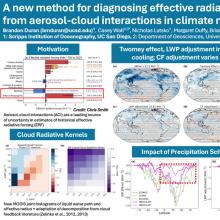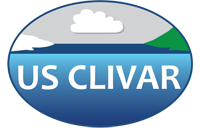A new method for diagnosing effective radiative forcing from aerosol-cloud interactions in climate models
Brandon
Duran
Scripps Institution of Oceanography
Poster
Aerosol effects modify clouds and perturb the global radiation balance, contributing to a significant amount of the uncertainty in the effective radiative forcing (ERF) of the climate.
The ERF resulting from aerosol-cloud interactions (ERFACI) offsets a highly uncertain, but potentially large part of the positive, well-constrained historical greenhouse gas forcing. This study diagnoses the ERFACI from liquid clouds in a multi-model ensemble of CMIP6 models using radiative kernels and a new method adapted from the cloud-feedback literature [Zelinka et al., 2012]. The method provides the ability to separately assess the shortwave ERFACI components resulting from the Twomey effect, liquid-water-path (LWP) adjustments, and cloud-fraction (CF) adjustments. While other methods for decomposing ERFACI typically require output on sub-daily timescales and multiple calls to the radiation code, this new method only requires monthly cloud droplet effective radius (CER)-LWP joint histograms. Understanding the relative contributions of the Twomey effect, LWP adjustment, and CF adjustment to the historical shortwave ERFACI offers important physical insight into climate forcing, and we provide new estimates of the Twomey effect and cloud adjustments to compare against CMIP5 models. This study highlights the feasibility of a new, more computationally efficient method for estimating the components of SW ERFACI in model ensembles with the introduction of a MODIS CER-LWP joint histogram diagnostic. The new MODIS diagnostic also provides opportunities for model validation, as simulated liquid-cloud distributions in the CER-LWP space can be compared against MODIS observations to quickly explore amount and distributional biases.
The ERF resulting from aerosol-cloud interactions (ERFACI) offsets a highly uncertain, but potentially large part of the positive, well-constrained historical greenhouse gas forcing. This study diagnoses the ERFACI from liquid clouds in a multi-model ensemble of CMIP6 models using radiative kernels and a new method adapted from the cloud-feedback literature [Zelinka et al., 2012]. The method provides the ability to separately assess the shortwave ERFACI components resulting from the Twomey effect, liquid-water-path (LWP) adjustments, and cloud-fraction (CF) adjustments. While other methods for decomposing ERFACI typically require output on sub-daily timescales and multiple calls to the radiation code, this new method only requires monthly cloud droplet effective radius (CER)-LWP joint histograms. Understanding the relative contributions of the Twomey effect, LWP adjustment, and CF adjustment to the historical shortwave ERFACI offers important physical insight into climate forcing, and we provide new estimates of the Twomey effect and cloud adjustments to compare against CMIP5 models. This study highlights the feasibility of a new, more computationally efficient method for estimating the components of SW ERFACI in model ensembles with the introduction of a MODIS CER-LWP joint histogram diagnostic. The new MODIS diagnostic also provides opportunities for model validation, as simulated liquid-cloud distributions in the CER-LWP space can be compared against MODIS observations to quickly explore amount and distributional biases.

duran-brandon-poster.pdf
(470.55 KB)
Meeting homepage
